There’s something magical about the aroma of slow-roasted meat wafting through the kitchen. And this Oven Baked Beef Brisket recipe promises to deliver exactly that. Picture a tender, juicy slab of beef, seasoned to perfection with a remarkable brisket rub.
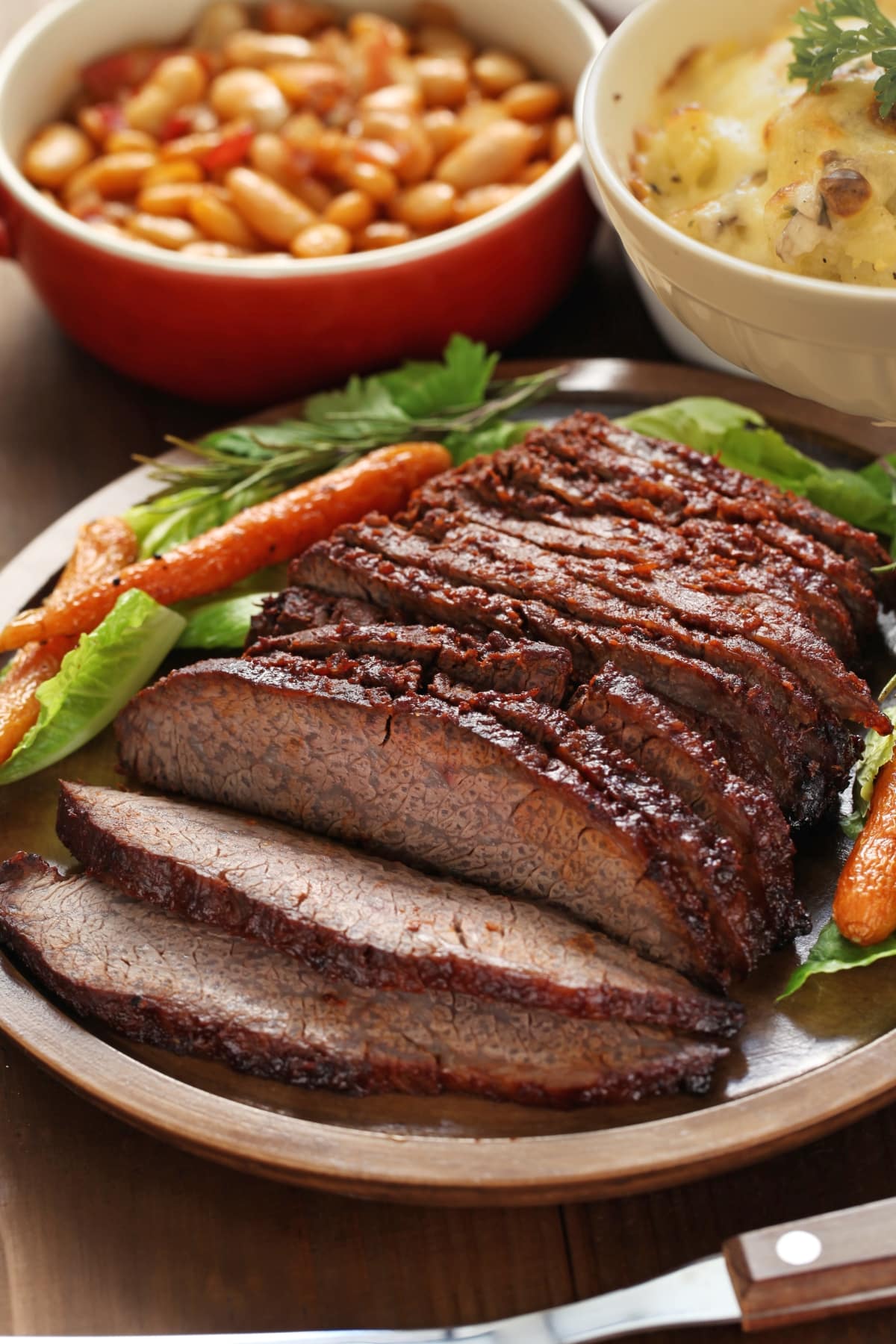
Table of Contents
By far, this is one of my favorite recipes for holidays, family gatherings, and cool winter days. The flavor and the simplicity make it the best way to slow-cook a brisket. Brisket is a popular cut of beef because it’s so flavorful when cooked the right way. Every bite has an explosion of smoky, savory flavors.
This recipe is an adaptation of Nach Waxman’s original brisket recipe. It is a mash up of cherished family recipes. Follow along to learn the two distinct steps that make the brisket so exceptional.
Serve this brisket with crispy roasted new potatoes, roasted carrots, delicious corn fries, and tasty elote, and you will have a memorable feast. For leftover brisket tacos, be sure to check out how to warm tortillas.
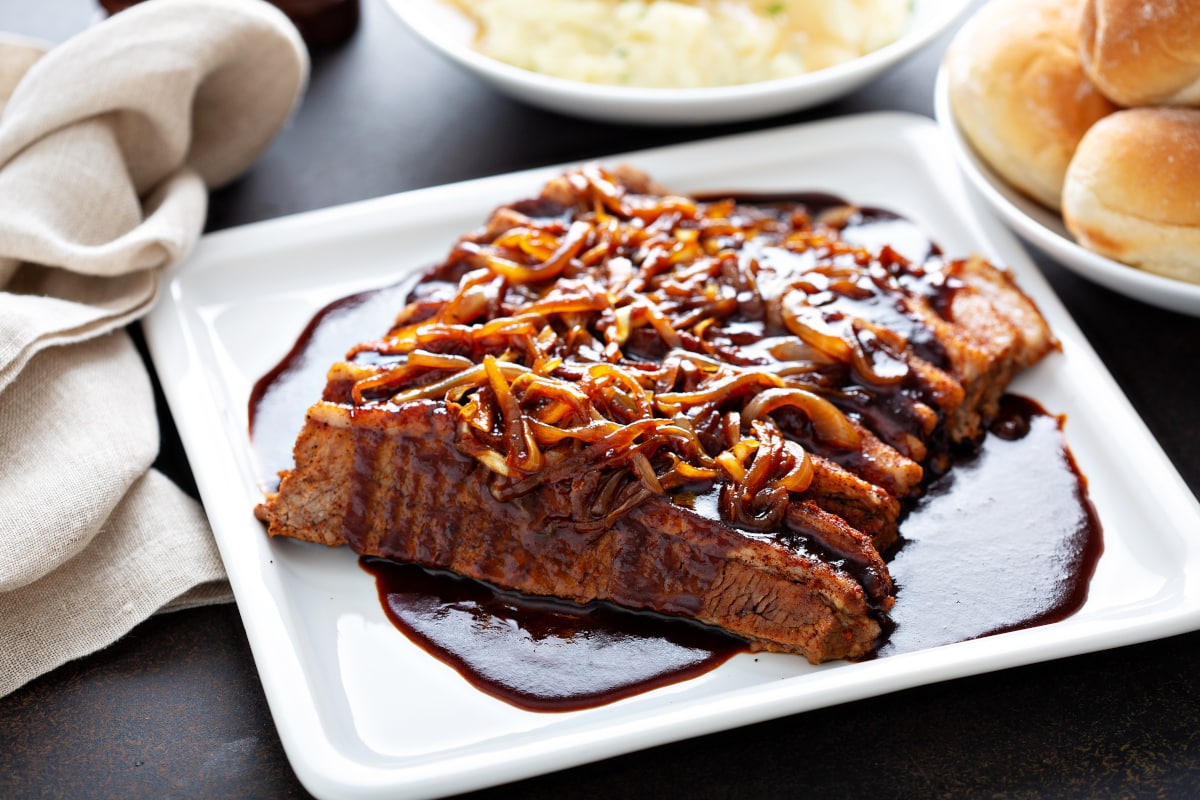
Why This Recipe Works
- Cooking brisket in the oven is very forgiving to make for the home cook. You will find it much easier to make a perfect brisket for the first time in the oven. It is much easier than making a smoked brisket or grilled brisket.
- It only uses the brisket flat and not the whole brisket. If the flat end cut is too large, ask your butcher to cut it into smaller sections. You don’t want to be dealing with a monster cut of beef.
- Beef brisket is perfect for making ahead of time. It might even taste better the next day. The leftovers are fabulous. You can use leftover brisket in sandwiches, tacos, sliders, over fries, and even as a topping for pizza!
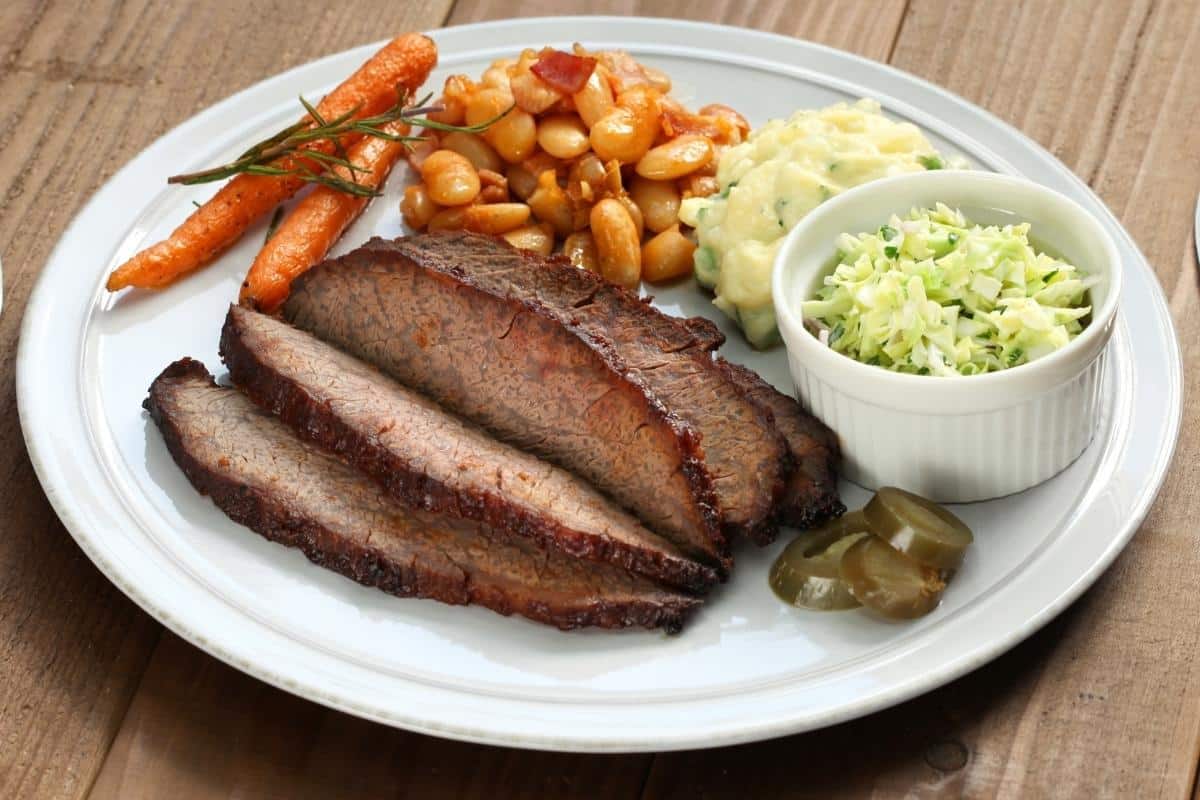
Ingredients
Best Dry Brisket Rub
- Brown sugar, coarse kosher salt, smoked paprika, chili powder, mustard powder, and ground black pepper.
Baked Brisket
- Beef brisket – This cut is from the bottom front chest area of the cow. That muscle gets a lot of use which is why it is a tough cut of meat. For this recipe, a flat cut or first cut works perfectly. Make sure your cut has a thin fat cap.
- Fats – Use both vegetable oil and butter. The oil is for searing the brisket. The butter is for sautéing the onions which makes them a rich brown color.
- Onions – There are 8 onions in this recipe which may sound like a lot, but they add rich umami and sweetness to the roast.
- Garlic cloves – The sliced cloves add a buttery, sweet flavor to the brisket during roasting.
- Tomato paste – Concentrated tomato flavor adds sweetness and a bit of acidity when used as a baste.
- Carrot – Another layer of sweet flavoring comes from a whole roasted carrot.
The exact measurements for these ingredients are in the recipe card.
How to Trim a Brisket
If you are using a full packer brisket, or just want to know more about how to trim a brisket and learn how to cut across the different grains this video from Food Fire Friends has great videos and explanations on how to trim a brisket. They have a great instructions, images and video to help you.
Variations
You can substitute regular paprika for smoked paprika if you don’t like the smoky taste. Some recipes call for liquid smoke, but I feel that overpowers the intended flavor profile.
For a spicier flavor, add 1/4 to 1/2 teaspoon of red pepper flakes to the dry rub.
How To Make Tender Brisket
- Preheat the oven to 375°F.
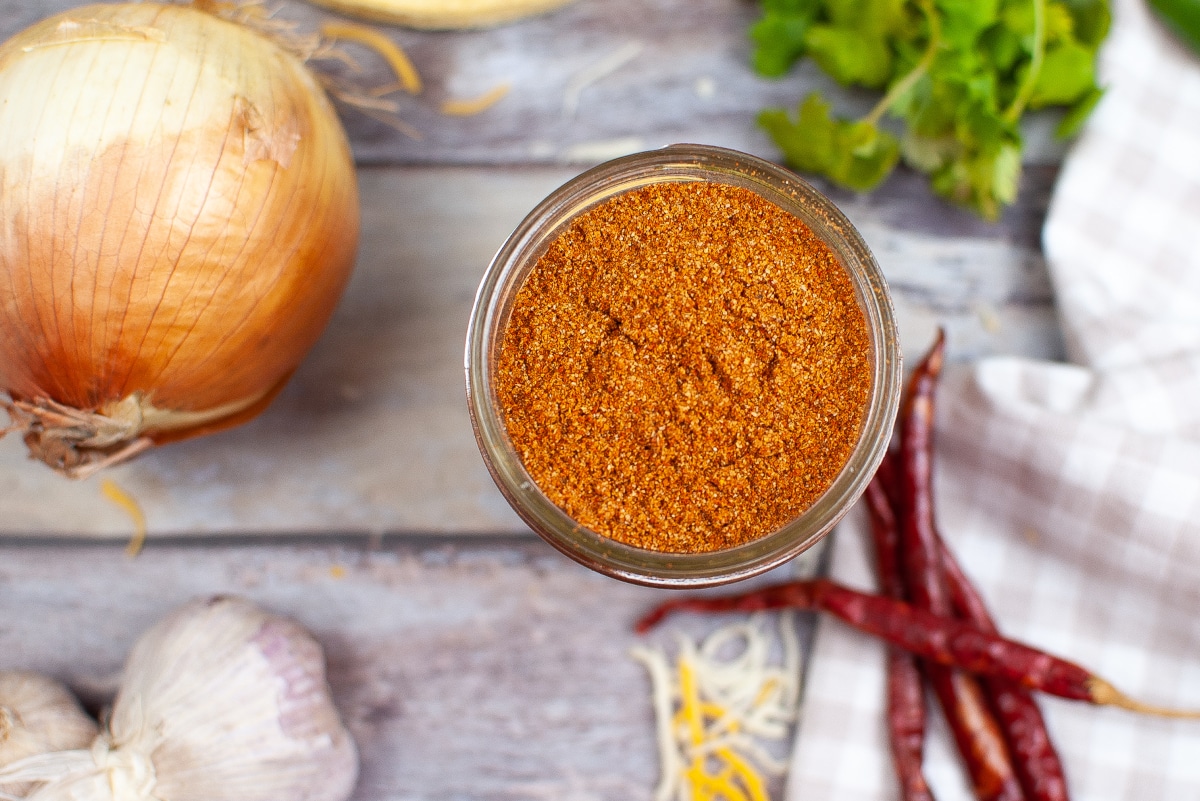
- Prepare the dry rub by mixing all the ingredients in a small bowl.
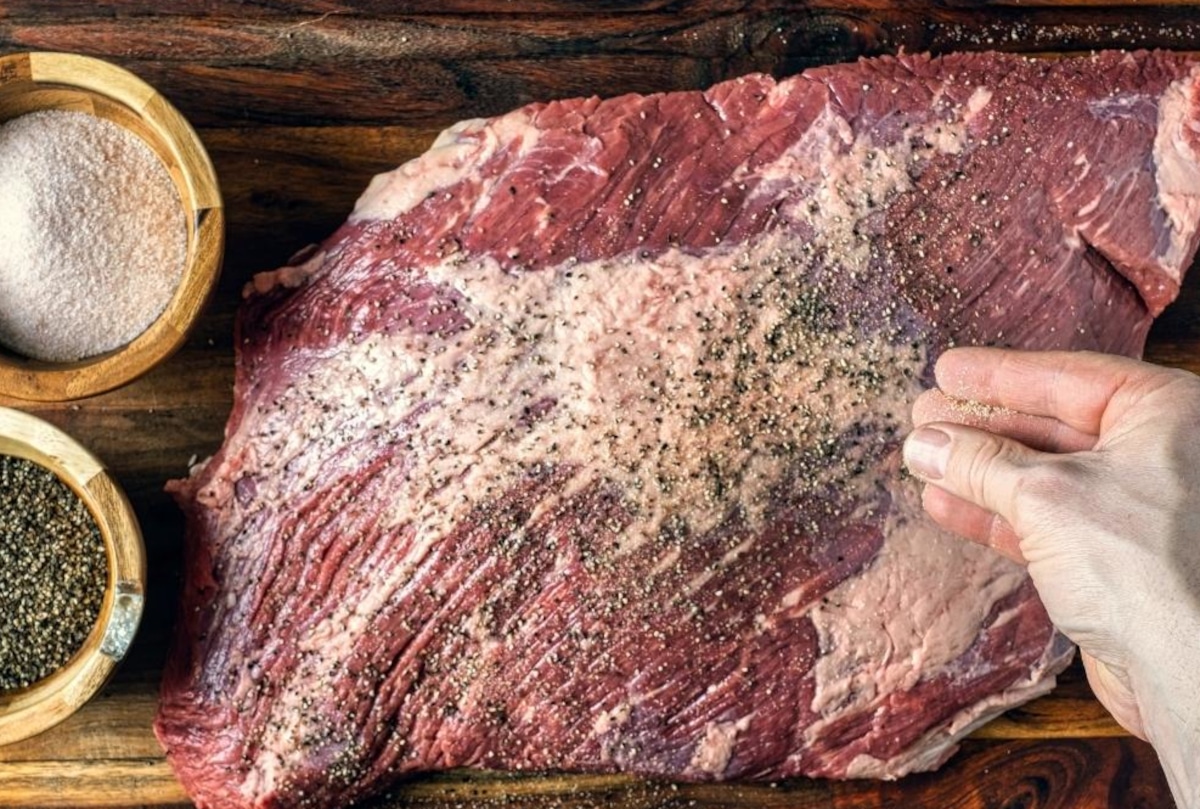
- Pat the brisket dry with a paper towel. Place the brisket on a baking sheet or work surface. Then sprinkle the dry rub all over the brisket and gently pat on the rub.
- Heat the oil in a roasting pan or a Dutch oven until shimmering. Add the brisket and cook, turning once, until crusty and brown areas start to appear. This step will take about 10 to 14 minutes. Transfer the brisket to a platter.
- Add the butter and cook until melted. Add the onions and cook, stirring continuously with a wooden spoon. Cook the onions until softened and a rich brown color. This step with also take about 10 to 14 minutes. Do not caramelize the onions.
- Remove the pan from the heat. Place the brisket fat side up on the onions. Pour any accumulated juices from the platter over the brisket.
- Spread the tomato paste over the top of the brisket using a small spatula. Finally, add the garlic and carrot to the pot. Cover the brisket and put it in the oven at the higher temperature for 1-1/2 hours. Do not disturb the brisket during this stage.
- Reduce the oven temperature to 325°F.
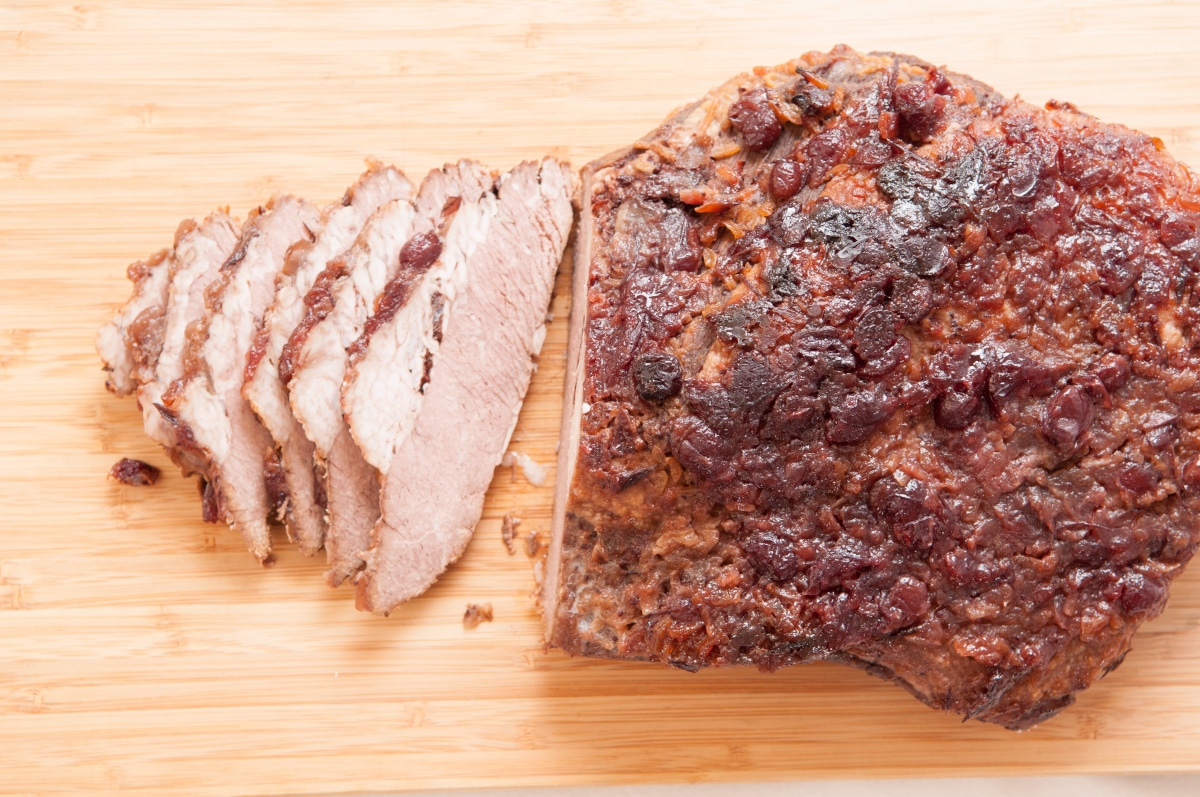
- Transfer the brisket to a cutting board. slice the brisket across the grain using a sharp butcher knife. Arrange the slices back into the Dutch oven. Overlap them at an angle so you can see a bit of each slice’s top. Add 2 to 3 tablespoons of water to the bottom of the pot if it looks dry.
- Cover the brisket and return to the low temperature oven. Drizzle the meat occasionally with pan juices. Cook for about 2 hours. The low heat will break down the connective tissue making very tender beef brisket.
- The brisket is done when it is fork tender. A good rule of thumb is to cook until the internal temperature is above 190 degrees Fahrenheit but not over 205 degrees. Use an instant-read meat thermometer to test the internal temperature. Keep covered and let the brisket rest for 15 to 30 minutes.
- Arrange the brisket slices on a platter and spoon some of the pan juices over the top. Arrange the onions from the Dutch oven around the brisket.
- Serve warm with side dishes and optional gravy.
Optional gravy recipe:
Follow the instructions for my beef gravy recipe using the pan juices. In step 10 you can transfer the brisket slices and onion to the serving platter and cover it with aluminum foil to rest. Then make the gravy in the Dutch oven.

For best results, use an instant-read thermometer to test the internal temperature of the brisket. The cooking time can be different based on the brisket itself and variations in oven temperatures.
Use the right roasting pan. Your roasting pan should be an ovenproof cast-iron pot, Dutch oven, or roaster. It needs to be heavy-bottomed and sturdy. You will also want your beef brisket to fit snugly inside the pot.
Make sure the lid fits well. If you don’t have a pot that has a matching lid, you can always use heavy-duty aluminum foil and seal it around the edges of your pot.
An Instant-Read Thermometer is a must needed tool when cooking brisket.
Cooks Tips
- Don’t rush it. Low and slow cooking is the key to the most amazing brisket. While this braising recipe takes a long period of time to cook, that time is mostly hands-off. Plus, it is so worth it!
- Pay attention to the liquids. You do not want your brisket to get dry so keep checking if you need to add water. But, only add water in 1 tablespoon increments – you do not want to braise the brisket.
- Use all the onions. Don’t even think about making less than eight onions. It works.
- To cook larger portions, make sure you have the Dutch oven or roasting pan that fits. If necessary, you could find 2 or more smaller cuts of the brisket at the grocery stores. Smaller cuts may be easier for you to handle.

Storing and Reheating
As I mentioned earlier, your brisket might even taste better the next day. So here is how you want to handle one of the best beef brisket recipes ever.
Plan for leftovers. Leftover brisket is great warmed up or you can use it for sandwiches, sliders, tacos, and more. This beef brisket recipe will feed 10 to 12 people with about 5 to 7 ounces per person, after allowing for shrink. A typical serving size is 4 to 6 ounces. The amount of leftovers depends upon the appetite of your guests and the side dishes you serve.
If you make beef brisket ahead of time, let the brisket cool, cover it with foil, and refrigerate it overnight.
To Reheat. Preheat oven to 325°. Skim off any fat from the surface of the beef brisket. With the brisket in the Dutch oven, cover it and reheat it for 1 hour or until heated through.
Cooked brisket can be refrigerated in an airtight container for up to 5 days.
Uncooked brisket can be refrigerated in an airtight container for 3 to 5 days. Raw brisket can be frozen for 6 to 12 months. I recommend you defrost the brisket in the refrigerator. Once it is defrosted, you can refrigerate it for another 3 days.
Frequently Asked Questions
Can I bake a brisket without wrapping it in foil?
Yes, but it may dry out more quickly. Leaving the brisket unwrapped in the oven helps build a crust or “bark” on the outside, similar to smoking. However, for a juicier brisket, most people cover it with foil or a roasting pan lid after the first couple of hours. You can always go uncovered at the end to crisp up the bark if needed.
Why does my oven-baked brisket turn out tough even after hours of cooking?
You may be cooking it at too high a temperature, not letting it rest, or not carving across the grain. Brisket needs low and slow heat to break down its connective tissue. Even if it’s been in the oven a long time, 325°F or higher can dry it out before it gets tender. Always let it rest to redistribute juices.
Should I sear the brisket before putting it in the oven?
It’s optional, but it can add flavor. Searing the brisket in the Dutch oven creates a brown crust, which adds extra depth to the flavor. However, it is not necessary, especially if you’re baking low and slow with a spice rub that will develop its own crust.
This oven-baked beef brisket recipe is a true labor of love, requiring a bit of patience, but the result is well worth the wait. Whether you’re planning a holiday feast or simply craving a hearty, satisfying meal, this Oven Baked Beef Brisket will undoubtedly become a star on your dining table.
Famous Oven Baked Beef Brisket
Equipment
- Dutch Oven
- Instant Read Themometer
Ingredients
Best Brisket Rub
- 1 tablespoon packed brown sugar
- 1 tablespoon coarse kosher salt
- 1-1/2 teaspoons smoked paprika
- 3/4 teaspoon chili powder
- 1/2 teaspoon mustard powder
- 1/2 teaspoon freshly ground black pepper
Brisket
- 6 pound brisket flat, trimmed so that a thin layer of fat remains
- 3 tablespoons vegetable oil
- 2 tablespoons butter
- 8 medium onions peeled and thickly sliced
- 4 garlic cloves peeled and quartered
- 3 tablespoons tomato paste
- 1 carrot peeled and trimmed
Instructions
- Preheat the oven to 375°F.
Best Brisket Dry Rub
- In a small bowl, combine the brown sugar, salt, paprika, chili powder, mustard powder, and black pepper.
Brisket
- Using paper towels, pat the brisket flat dry. Sprinkle the dry rub all over the brisket. Gently pat the rub onto the brisket.
- In a large Dutch oven over medium-high heat, add the oil and heat until shimmering. Add the brisket to the Dutch oven and cook, turning halfway through cooking time, 10 to 14 minutes or until scattered crusty and browned areas appear on the brisket. Transfer the brisket to a platter.
- Add the butter to the Dutch oven and cook until the butter is melted. Add the onions and cook, stirring constantly with a wooden spoon. Continue cooking and scraping up any browned bits from the bottom of the Dutch oven, for 10 to 15 minutes or until the onions have softened and developed a rich brown color. Do not caramelize them. Remove from the heat. Place the brisket on the onions and pour any accumulated juices on the platter over the brisket.
- Using a knife or a small spatula, spread the tomato paste over the brisket. Add the garlic and carrot to the pot. Cover the brisket, transfer it to the oven, and cook, untouched, for 1-1/2 hours.
- Reduce the oven temperature to 325°F.
- Transfer the brisket to a cutting board. Using a very sharp knife, thinly slice the brisket across the grain into approximately 1/8-inch-thick slices. Return the slices to the pot, overlapping them at an angle so that you can see a bit of the top edge of each slice. If absolutely necessary, add 2 to 3 teaspoons of water to the pot.
- Cover the brisket and cook, occasionally drizzling the meat with pan juices, for about 2 hours, If the pan juices have evaporated, add up to a tablespoon of water and return to the oven.
- When the brisket is fork-tender and the internal temperature is above 190°F and not over 205°F, remove it from the oven. Let it stand, covered, for 15 to 30 minutes.
- Arrange the brisket slices on a platter and spoon some of the pan juices over the brisket to barely moisten it.
- Arrange the onions from the Dutch oven around the brisket. Serve warm with your chosen side dishes.

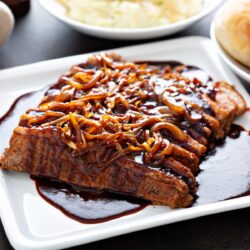
Looks so yummy! Can’t wait to give it a try! 🙂